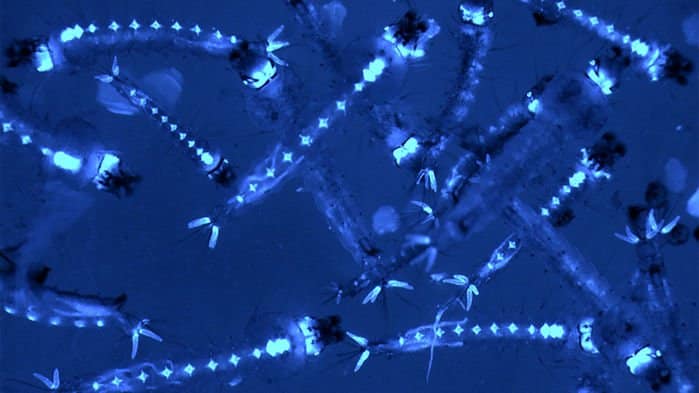Mosquito Gut Flora Could Hold Key To Cutting Malaria Spread
Malaria persistently evades our best efforts to eliminate it. The huge burden of malaria in developing countries urgently demands the development of novel approaches to fight this deadly disease. Although engineered symbiotic bacteria have been shown to render mosquitoes resistant to the parasite, the challenge remains to effectively introduce such bacteria into mosquito populations.
Now however, two new papers by researchers at the Johns Hopkins Bloomberg School of Public Health’s Malaria Research Institute report successes for highly promising strategies against malaria.
The two studies have discovered different ways by which resistance to the malaria parasite can spread into a mosquito population, potentially opening the way for the development of self-propagating malaria control strategies.
Malaria is spread by the female Anopheles mosquito that bites an infected person and then, after the disease-causing parasites incubate inside the insect’s gut, pass on the infection by biting someone else. People, animals, even insects harbor a community of mostly healthy intestinal bacteria, what’s called the gut microbiome. Researchers have long known that some of those natural mosquito germs are capable of attacking malaria parasites. So it begs the question, regarding how to spread that protection
to enough mosquitoes in the wild to make a difference.One team of researchers discovered a strain of bacteria that can spread rapidly and persist long-term among malaria-carrying mosquitoes. A genetically modified version of that strain strongly suppresses development of the malaria parasite, making the mosquitoes much less likely to transmit these parasites to humans.
While a second research team discovered that a genetic modification that boosted the immune system of malaria-carrying mosquitoes not only suppresses malaria parasites in the insects but also can spread quickly in a test population by changing the mosquitoes’ mating preferences.

The first team at Jacobs-Lorena’s lab have found a fluid in a mosquito ovary that seemed cloudy to him—a possible indicator that it harbored bacteria. The bacterial variety he discovered, a new strain in the common genus Serratia, loved to spread. When female Anopheles gambiae mosquitoes ate sugar laced with the Serratia, it quickly populated their guts. The bacterium appeared on the surface of their eggs, and even spread to the larvae when they hatched. And it could also be transmitted sexually from males to females.
The microbe seemed to have no negative effects, so the researchers equipped it with anti-Plasmodium genes. They engineered it to produce five molecules with different methods of killing, trapping, or hobbling Plasmodium in the gut. In mosquitoes fed the genetically engineered bacterium 2 days before drinking Plasmodium-infected blood, the researchers detected about 93% fewer parasites than in their untreated counterparts. The results are published online today in Science.
It remains to be seen whether the mosquitoes will share the bacterium as readily in the wild as they do in a lab. Jacobs-Lorena’s team is preparing an enclosure at a facility in southern Zambia—complete with “vegetation and flowers and a little hut,”- to test transmission in a more realistic setting.
The second investigation led by George Dimopoulos, also a professor of molecular microbiology and immunology, made small modifications to the DNA of malaria-transmitting Anopheles mosquitoes to boost the activity of their immune genes. The enhanced immunity made the mosquitoes more resistant to infection by malaria parasites, and thus less likely to transmit the parasites to humans.
That result was expected. What was not expected was the unusually high efficiency with which the modified mosquitoes spread their genetic modification to later generations in a mixed population of modified and unmodified, wild-type mosquitoes.
Investigating this surprising result, Dimopoulos and colleagues found that boosting the mosquitoes’ immune genes also altered the mix of bacterial species in the mosquito intestine and reproductive organs. This change in the insect “microbiota” in turn led to a change in mating preferences: Modified male mosquitoes began to prefer unmodified, wild-type females, while wild-type males began to prefer modified females.
Dimopoulos’s modified mosquito population has now been living in a colony in his laboratory for more than seven years, and has retained its high level of resistance to malaria for all that time without any apparent adverse side effects. “These mosquitoes haven’t changed in terms of feeding behavior or any other things that could be of concern,” Dimopoulos says.
“We believe that by changing the microbiota we’re changing the scent of modified mosquitoes- which in turn alters mating preference,” says Dimopoulos. “It’s the perfect change in mating preference in this case, because it maximizes the chances of producing genetically modified offspring when mosquitoes compete for mates.”
Penn State University entomologist Jason Rasgon said the findings are exciting because they go beyond the hunt for better malaria control. “It’s a new avenue of fundamental mosquito biology — how the microbiome affects behavior,” he said.
Both studies were supported by the National Institute of Allergy and Infectious Diseases and the Bloomberg Philanthropies. The first study was also supported by the Strategic Priority Research Program of Chinese Academy of Sciences and the National Nature Science Foundation of China.
The two discoveries are similar to gene drives—phenomena where genes have more than the usual 50-50 chance of entering the next generation, and can zoom through populations. But success is still a long way off with many technical hurdles to overcome, and ethical debates to wrestle with. For a start, this approach—just like Dimopoulos’s and Jacobs-Lorena’s projects—involves genetic modification, which is still a fraught and polarizing issue.






























